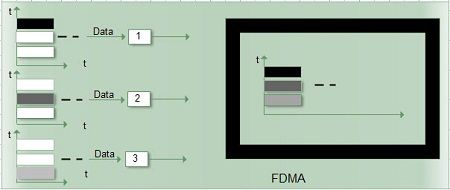• In FDMA, the available bandwidth is divided into various frequency bands.
• Each station is allocated a band to send its data. This band is reserved for that station for all the time.
• The frequency bands of different stations are separated by small bands of unused frequency. These unused frequency bands are called guard bands that prevent station interferences.
• FDMA is different from frequency division multiplying (FDM).
• FDM is a physical layer technique whereas FDMA is an access method in the data link layer.
• FDM combines loads from different low bandwidth channels and transmit them using a high bandwidth channel. The channels that are combined are low-pass. The multiplexer modulates the signal, combines them and creates a band pass signal. The bandwidth of each channel is shifted by the multiplexer.
• In FDMA, data link layer in each station tells its physical layer to make a band pass signal from the data passed to it. The signal must be created in the allocated band. There is no physical multiplexer at the physical layer.

 Dinesh Thakur holds an B.C.A, MCDBA, MCSD certifications. Dinesh authors the hugely popular
Dinesh Thakur holds an B.C.A, MCDBA, MCSD certifications. Dinesh authors the hugely popular